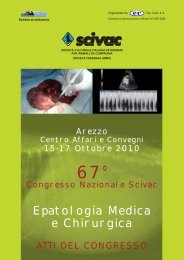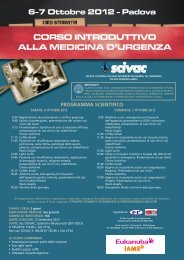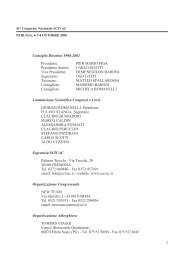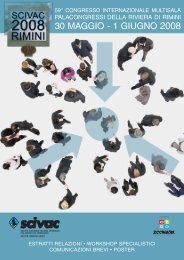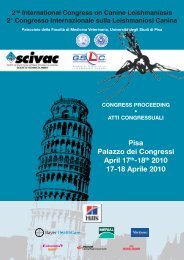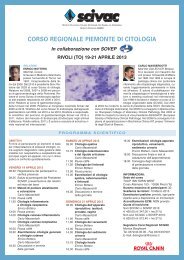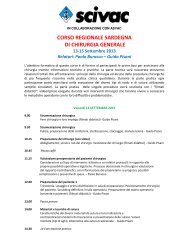58° Congresso Nazionale SCIVAC: Oncologia veterinaria
58° Congresso Nazionale SCIVAC: Oncologia veterinaria
58° Congresso Nazionale SCIVAC: Oncologia veterinaria
You also want an ePaper? Increase the reach of your titles
YUMPU automatically turns print PDFs into web optimized ePapers that Google loves.
58° <strong>Congresso</strong> <strong>Nazionale</strong> <strong>SCIVAC</strong> • Milano, 7-9 Marzo 2008 • <strong>Oncologia</strong> <strong>veterinaria</strong> - Alle soglie del III Millennio<br />
Contraindications<br />
Myelosuppression, characterized by leukopenia and thrombocytopenia,<br />
necessitates dose delay. Treatment should be interrupted in patients who develop<br />
infections. Because of the importance of renal excretion, patients with<br />
renal failure should receive alternative alkylating agents or should have the<br />
dose reduced or interval increased. Guidelines for dose modification in the face<br />
of renal insufficiency have not been well established. Patients that develop<br />
sterile hemorrhagic cystitis should discontinue the use of cyclophosphamide,<br />
or should only receive the drug concurrently with the urothelial protectant<br />
compound 2-mercaptoethanesulphonate (mesna). Therapy should be discontinued<br />
in case of anaphylactic reactions, or known sensitivity.<br />
CHLORAMBUCIL<br />
Chlorambucil is an aromatic derivative of mustargen. It is the slowest acting<br />
and generally least toxic of the commonly used alkylating agents.<br />
Mechanism of action<br />
As with other classical alkylating agents, chlorambucil preferentially binds the<br />
7-N position of guanine. Chlorambucil is a bifunctional alkylator in that it can bind<br />
to two DNA strands as well as DNA and a macromolecule. DNA damage includes<br />
base mispairing, DNA template misreading, and spontaneous depurination.<br />
Pharmacokinetics<br />
Chlorambucil is readily absorbed after oral administration, leading to peak<br />
plasma levels after 2-4 hours. Food can interfere with absorption. The dose used<br />
in veterinary medicine ranges from 2-6 mg/m 2 PO given every other day, or up to<br />
20 mg/m 2 PO administered every 3 weeks. Chlorambucil is metabolized in the liver<br />
to an alkylating metabolite, phenyl-acetic acid mustard, which is degraded before<br />
being excreted by the kidneys. Chlorambucil is extensively protein bound.<br />
Toxicity<br />
Bone marrow suppression is the most significant side effect. Myelosuppression<br />
secondary to chlorambucil seems to be less severe than that of cyclo-<br />
59



